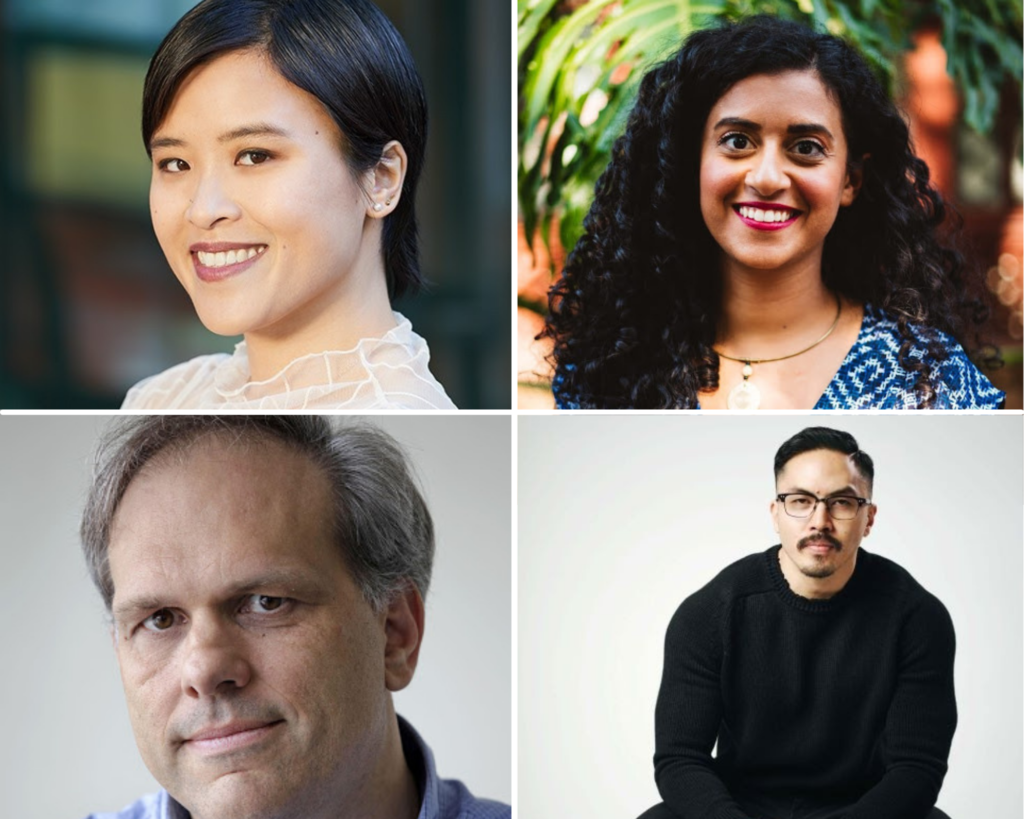Jacky Habib, Anita Li, Rudy Lee and Ivan Semeniuk began teaching in January

The new instructors at the Ryerson School of Journalism (RSJ) continue to widen the scope of knowledge and experience available to students. Two of the instructors are Ryerson graduates and all of them are active journalists in the industry.
Jacky Habib is teaching multimedia news reporting to first year students and Ivan Semeniuk teaches science and health journalism. Anita Li has joined to teach journalism innovation in the masters program, while Rudy Lee is teaching a fact-checking course to second and third year undergraduate students.
Habib is a RSJ graduate and has gone on to create New Lens Travel, an educational travel company where budding storytellers have the opportunity to travel abroad to learn from local journalists in Ghana and Kenya.
While this is Habib’s first time as a university instructor, she has extensive experience in media training. At Artscape, a non-profit in Toronto, she helps shape the next generation of story-tellers, and she trained citizen journalists in Ghana through Journalists for Human Rights.
Habib said since she graduated in 2011, so much has changed in journalism and it’s exciting to be “on the other side” of the classroom.
“Some of the things that weren’t so much of a focus when I was a student now I see them as being so essential to student learning and being able to build your career,” said Habib. “Learning about the business of freelancing, and how to market yourself and build a personal brand have become increasingly important to becoming a successful journalist.”
“I never planned to be a freelancer,” she said, but the nature of the modern media landscape demanded it of her. “I’ve carved a path for myself in journalism that is quite different from what we typically see,” said Habib. “I’m excited to share my experience with emerging journalists so they can learn to dream bigger and really go after what they want.”
Semeniuk was the Chief of Correspondents at the American organization Nature Research, which publishes cutting edge discoveries and analysis from the science community. In the field, Semeniuk has reported on everything from science politics, astronomy, physics to biology.
Alongside his new teaching position, Semeniuk continues to work at the Globe and Mail as a health science reporter and will be bringing that knowledge to the classroom. He has reported extensively on the COVID-19 outbreak and plans to teach pandemic reporting, specifically.
Li started this January teaching journalism innovation to Ryerson master’s students. “The cool thing about the course is that it’s pretty sprawling and it’s experimental,” said Li. “It’s about putting on your critical thinking hat (and) challenging norms in Canadian journalism.”
Earning a master in journalism from Carleton University, Li went on to write for organizations including Poynter Institute, Maclean’s and the Toronto Star, even speaking for TEDx about the power of digital journalism.
“I’m right in the thick of it,” said Li, who is also the founder of The Other Wave, a digital newsletter where she shares her insights on the industry of journalism and “challenging the status quo in Canadian Journalism.”
Modernizing Canadian journalism is Li’s passion. Although journalism innovation was an existing course, Li has completely revamped the curriculum and included her own research and experiential knowledge. She said she credits the school’s ability to give her autonomy while she enhances the course content.
Like Habib, Li feels that a crucial aspect of improving modern journalism schools is to teach the business side of media work. “It’s really important for students to learn how they’re getting paid and where their salaries come from,” said Li. “For them to understand whether the funding model of a media company aligns with their personal values.”
Lee, who is also a graduate of the RSJ, was named Ryerson’s first Verification Expert in Residence and brings a wealth of fact-checking expertise to the school. Over the course of his career, he has worked as researcher for Vogue, Architectural Digest, Reader’s Digest and Flare.
Currently, Lee works as a research editor at the New York Times in addition to teaching the new course on fact-checking. The class, called ‘Exactly So: The Challenge of Precision,’ has been remade by Lee and co-instructor Carly Lewis.
The Ryersonian welcomes these four individuals to the journalism faculty.
This story was updated February 8, 3:09 PM EST. Rudy Lee did not write for the publications listed — he was a researcher. The class he is teaching is not new to RSJ. Also, Lee did not describe fact-checking as ‘the core of responsible journalism’; this was paraphrased from the course description on Ryerson’s website.
